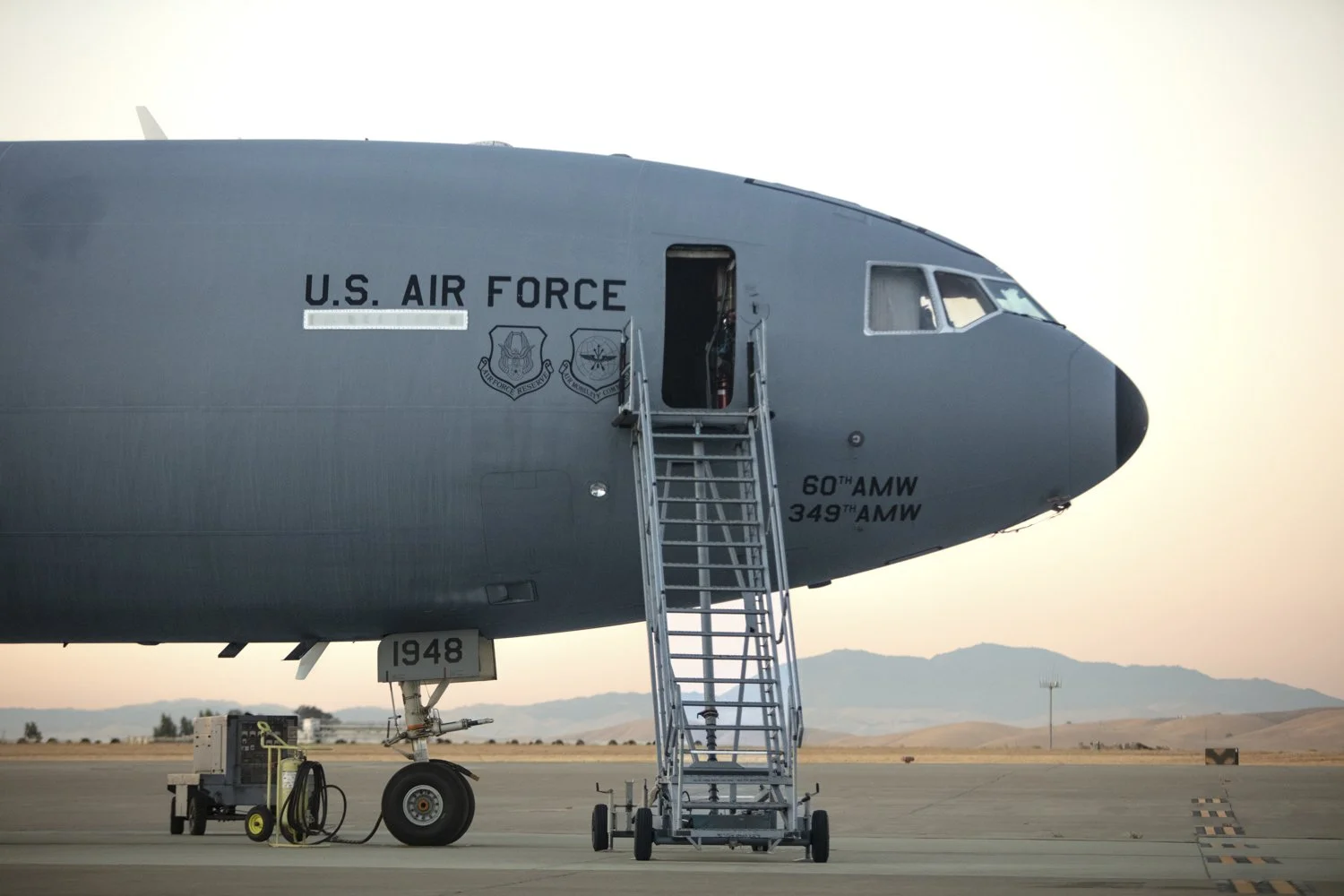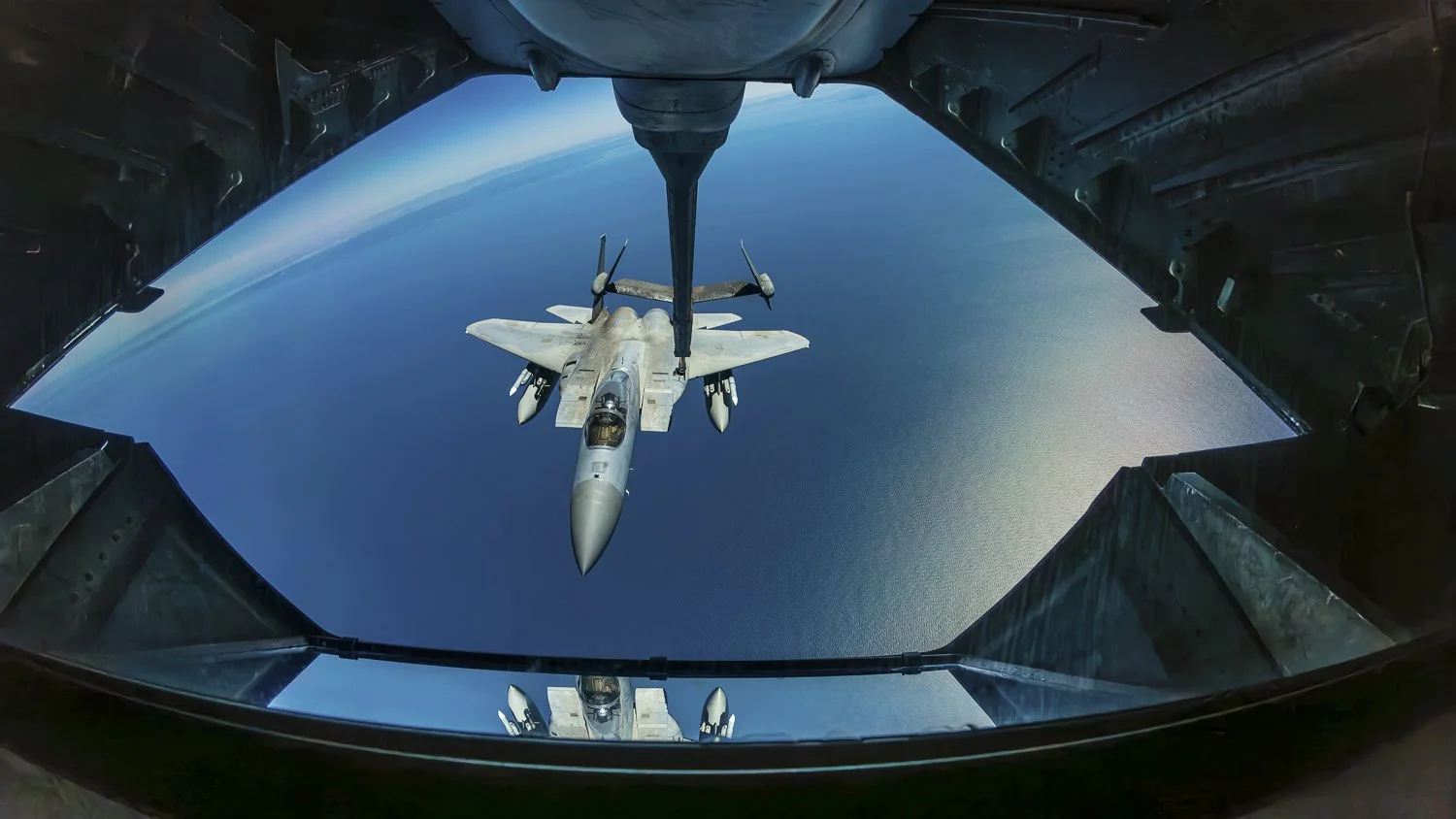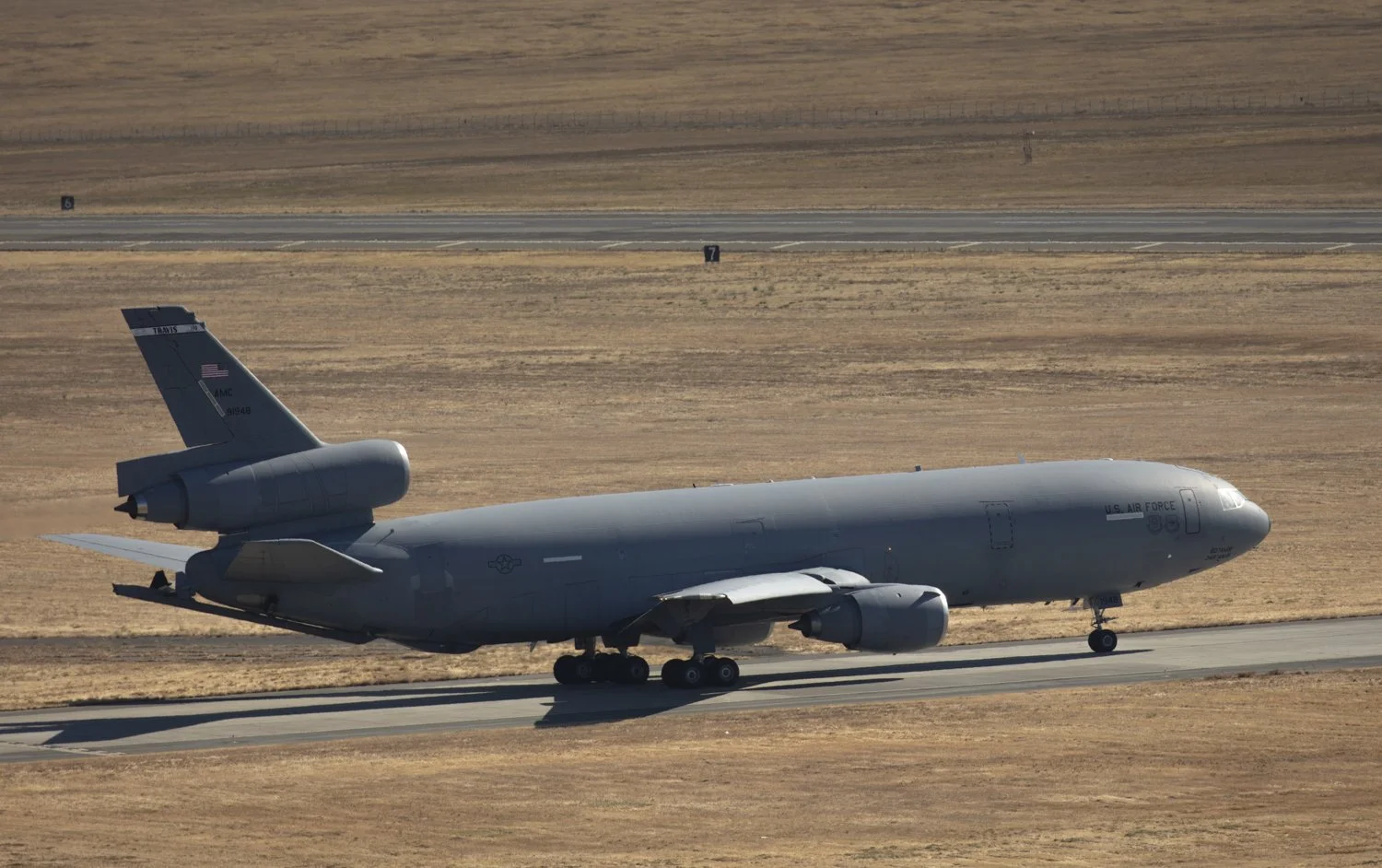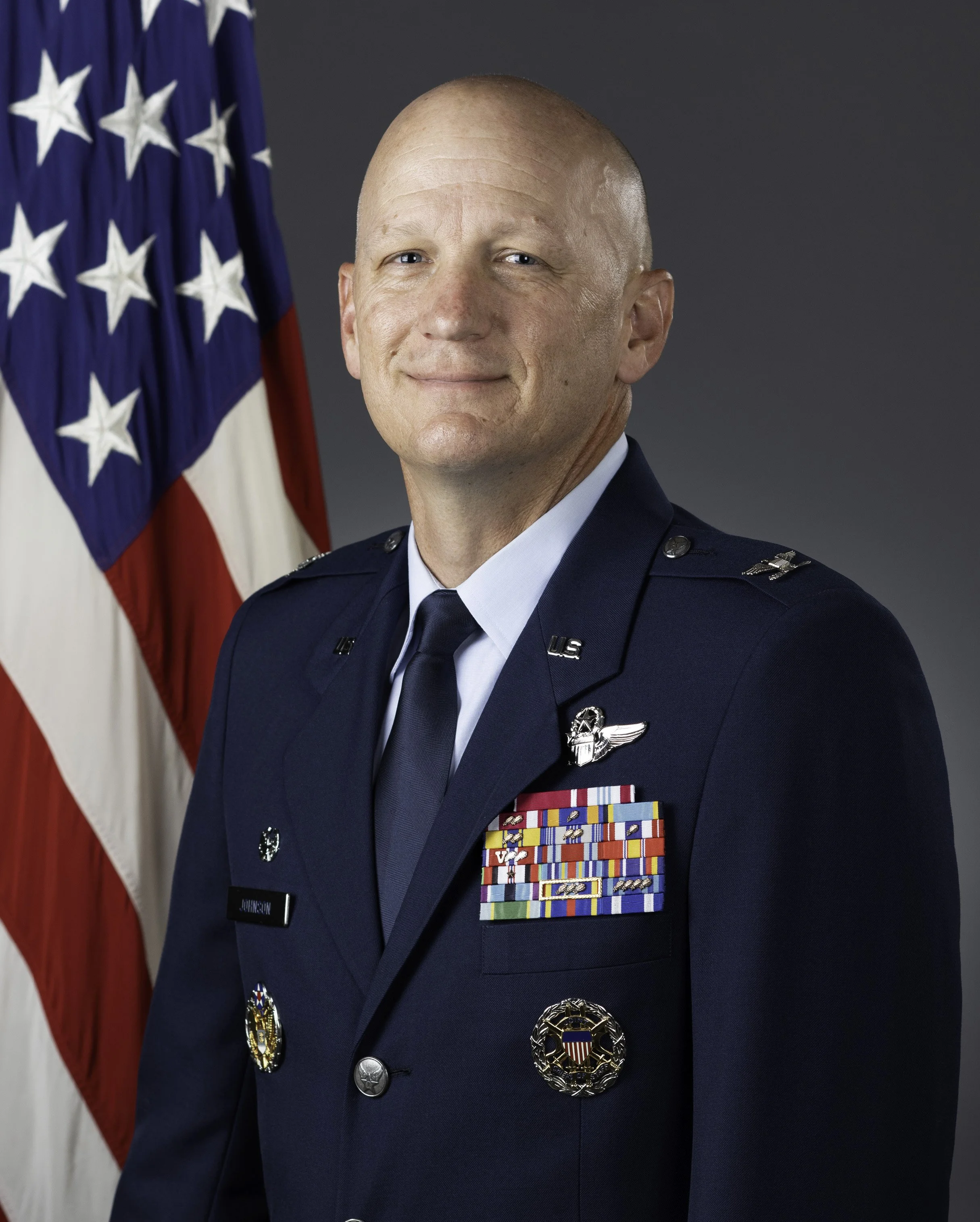RETIRING THE USAF KC-10 EXTENDER
Q&A with Travis Air Force Base 60th AMW Commander & former KC-10 pilot, Colonel Jay A. Johnson.
As dawn breaks over Travis Air Force Base, a US Air Force KC-10 Extender looms on the tarmac like a silent sentinel waiting for the call of duty. ©Alan de Herrera
CALLSIGN Magazine
Can you give me a little background on how the KC-10 has been integrated here at Travis with the Air Mobility Wing and the importance of that aircraft over the years.
Colonel Jay A. Johnson
So the KC-10 is integral to what we do here at Travis. So Travis is pretty unique. We are known as the gateway to the Pacific because of where we're actually physically located. The resources that are here, which includes the KC-10, if you look at the Indo, PACOM region, the Pacific and the tyranny of distance there, you need assets like tankers, right, to be able to cover those distances. And the KC 10 specifically is important there, because it's a multi-role tanker, right? It can be carrying cargo, dragging fighters and people all at the same time. And so that multi-role aircraft is really, really important, not across the world, but specifically in the Indo PACOM region as well. But you got them on both coasts right. Got them here at Travis, and you've got them at McGuire, because that tyranny of distance going in either direction, and that plays a vital role in it. You know, people look out at the ramp, they say, C-5, C-17 and KC 10s, right? And they assume that, you know, it's just those three planes that work together. And now KC-46 is but as you got to see yesterday, the KC 10.
I've been on flights that lasted 16 and a half hours and lost count of the number of types of airplanes that we refueled in doing that, right? So an extremely versatile airplane, really long legs, right? And you got to see the crew compliment as well. It's almost every mission I went on was usually a mixed crew between reserves and active duty as well. So the 10 plays a vital role here, a role that'll be filled by the 46 Pegasus here, got seven on the ramp now, but the KC 10 near and dear to my heart, right? Because I grew up on that airplane.
CALLSIGN
How many years did you fly that?
Col. Johnson
So first time from 2004 to 2010 and then the second time from 2014 to 2016.
CALLSIGN
Any particular stories that stand out to you of any like a particular flight that, yeah, there's mates with you.
Col. Johnson
Yeah, there's, there's a lot of them. I'll tell you the one that sticks out probably the most to me. So was in 2004 my first deployment to the Middle East in the KC 10. You know, had a, had a great crew there. Andy lay, I still remember this day was my co pilot, and we were, at that time coming out of our deployed location, and you didn't know what direction you were going. That day, you were either taking a right hand turn and going to Afghan Afghanistan, or left hand turn and go into Iraq. That night, we went to to Iraq, the one and only time that I've ever been shot at in an airplane was just south of Baghdad in 2004 57 millimeter to really, really big anti aircraft rounds that you get to see in tracers at night between us and 2f 16 rejoining on us. One of my most memorable case each.
CALLSIGN
Where you're doing a refueling?
Col. Johnson
right before, yeah, yep, we're pointed directly at the fighters. F 16 is pointed directly at us. Quickest Way To rejoin, you know, we turn. And you've seen that happen, probably in the air before. And then, yeah, 57 millimeter starts coming up in between the two of us. And that's it.
CALLSIGN
Can you tell me approximately what altitude you're at when that happened?
Col. Johnson
Yeah, we were in the low 20s, which, yep, 57 millimeter goes way higher than that, for sure. So one of those things that I can still see it in my mind today. You know, we at the time, had these virtual threat reality trainers, where you'd sit kind of in the sim, and you'd see these videos, and, you know, you're like, I'm never gonna see that. And then you see that, and you know exactly what it is. You're like, I've seen that before. So Andy and I still talk about that story too. He's an Alaskan Airlines pilot now, and we still talk about that story.
CALLSIGN
So that feeling at that point, what did that really trigger in your mind?
Col. Johnson
say that Andy screamed, but he may have screamed a little bit, right? We still make fun of him to that day. Truthfully, the training we receive in the Air Force is so good it kicks in. Yeah, it really does. You get that adrenaline rush immediately. And you go, what am I supposed to do? And you immediately start doing it really does kick in right away.
CALLSIGN
So at that point, then you refuel the F 16?
Col. Johnson
First thing we do is turn away from that location. I was gonna say, you went to a different fast as we can, right? And those guys follow us. You know, at the same time you're hitting Mark. To mark that location, right, so that you can radio that information so somebody can go take care of that might be those F 16 that are there with us. Wasn't that night? Yeah, the cool part, one of the cool parts about the KC 10, it's fast. It's really, really fast airplane. We would cruise around the world at Mach point eight, two, which is fast for that big of an airplane. I can tell you, on that night, it went much faster than that, went up to its operational limit, which is near point eight, eight, which is, you know, nearly going supersonic in a big airplane to get away from that stuff. But it's, you know, another one of the incredible capabilities that airplane. It's fast. So, yeah, we turned away, got out of the threat ring of that, and kept going, right?
CALLSIGN
What's that relationship like, between the people that are coming to refuel, obviously, your receivers, yeah, in those situations, like, you know, you have this, this, this symbiotic relationship right now. Obviously, you know, can you just describe that a little bit like.
View from the boom pod located in the rear of the KC-10 where the boom operator sits. ©Alan de Herrera
Col. Johnson
It's a great question,yeah, it's a jewel. Is not even a relationship. It's a bond, right? Because it's built on trust. Yeah, right. And I tell folks all the time that trust is earning pennies and spent on $100 bills, right? And if you as a tanker aren't doing the things that you need to do for for those receivers, that trust gets broken, right? And so be there. You have to be there, yeah? And I have had, you know, yeah, other stories where, you know, in Afghanistan, where you can literally be hundreds of miles apart. And I've had this before, to where you get that call, there's a high value target that particular story. And this is, you know, Afghanistan now, 2007 a 10s over, orbiting over a high value, value target. They're doing yo yo. So one stays over the target. Other comes up the tanker, back and forth, the tanker that had been there, which is a 135 and I won't make fun of the mini tanker, which is what we call the 135 of course, was out of fuel, right?
So we were literally in the south end of the country. They're up north in a track that used to be called Meg. And so here we go, point eight, eight across the country again to get there in time before they have to come off of that target, because that's our job, right? Part of our job is protecting those folks that are on the ground. And so you know that relate those guys, they their job is protect the people on the ground. Our job is to make sure they can do that. And that's another one of those where we're going. Hey, we will get you another tanker. It'll be there. You'll be okay. Stay over the target, and we'll get there. And you get there, and all the procedures and everything that we have in place, we have all kinds of different rendezvous we can do that. One is, you're like, I'm gonna point at you. I'm gonna get there as fast as I possibly can.
You pick me up on radar and come turn on me right. And you just, you know, they know that we're going to be there that. So it's, it's more than a relationship, it's a bond between those folks. And, you know, the other cool part, I'll tell you, you asked for stories. I've got all kinds of stories. That same deployment in Afghanistan, one of the coolest things I've ever seen. We have a b1 pull up behind us at night. That b1 you know, we're listening to all the radio frequencies. They come up. They're fully loaded. We get about half of the fuel that they need to get, and they get called to go strike a target, right? So they immediately disconnect the b1 where Depart of the 10 departs underneath, because it's so big and heavy, it can't back out like what you saw yesterday. It goes out in front of us. Lights all four after burners in that airplane, which is incredible to see at night, makes a hard U turn, and then we see him drop everything that they've got right so, massive explosion down there. And then they come right back to us, because when you light up all four of those engines, you burn through a lot of grass really fast. And just the demeanor of that crew from going, Hey, normal night, what's going on? You know, we're chit chatting back over the intercom to where they come back up, right? And they're like, like, you could just hear, you know, the adrenaline leaving their body and them decompressing from what, what they just did, you know? Yeah, you get to share those, those moments and those
CALLSIGN
Talk about that for a second. Yeah, absolutely, when, when in those situations, right? Wartime situations, and you have these pilots putting long hours in, doing sorties, and then they come. What's that that, you know, you have that bond, obviously. But what's that personal contact for you guys back and forth in those kind of situations?
Col. Johnson
Yeah, no, it doesn't training. It's, you know, so that's the cool part about the intercom. And in the 10 and menses, it's like, that's, that's our safe place, right? It's a secure, calm network, right? Where, if that crew, you know, they, what I find in most of situations, that people want to talk about it, right? Yeah, and we can do that with each other, because one, we in the tanker want to know how we're contributing to what's going on down there. We can listen over the frequencies and all that stuff, but, but we get to share that story and over a lot of those targets. And you've probably heard this before, there's, there's a stack of people that are doing that, right? You got reconnaissance, surveillance folks, you know, way up here. You probably got some command and control here. You got tankers here, and then you got the people actually dropping the bombs, and that whole team is working together, right? Yeah. And so we all kind of get to share, share that moment, but the moment when. Airplane connects to the boom, right? That's a secure system. It's hardwired there where you get to share kind of that moment and what's going on. And it's a sense of pride, yeah,
CALLSIGN
Is it also sometimes, maybe this not the right term, but a little therapeutic for them to just have a nice conversation, yeah? Like, like, a little reprieve.
Col. Johnson
Let's say I would think absolutely. And you know, the best boom operators are, you know how to talk, how to talk to those guys. you know, some of the coolest things I say to them, you know? Yeah. So, you know. So I'll give credit to the boom operators, right? So us as the pilots, yep, we're talking to them, but the boom operators and you've met since you handed over, yeah, yeah, there, that's the business end of the airplane right back there. Yeah. And I've seen some boom operators. You have some young pilots, fighter pilots, bomber pilots, that come up that are maybe pretty rattled after that stuff. Yeah. And I've heard boom operators talk them onto the boom right just going, Hey, you got to hold stable right there, you know? And maybe there's an envelope they're supposed to be in. And the boom operators, like he might talk to me over the intercom, which they can't hear, to go, hey, just crack the throttles a little bit. Let's just, we're gonna back up into position to get this guy, and they'll reach out and plug them. And so I've absolutely seen boom operators work as part psychologist back there to help, yeah, talk folks out of the boom and, yeah, get what they need. I've all seen boom operators send them home. Go, nope, get away from me. Like, yeah, this, we need to not do this today,
CALLSIGN
yeah, especially, you know, somebody's tired, you know. And that's a very absolutely, you know, you get takes so much concentration. It's an all weather airplane, right? So what we do this kind of ease them into that.
Col. Johnson
We do this at night, in the weather, low altitudes, all of it, right? And, and so absolutely.
CALLSIGN
So then, I guess, kind of one of the last questions in that relationship, then, for you guys as the as the pilots or the crew in the cockpit and your boom operator in the back, what's that like? And is, do the boom operators always switch out, or do they tend to always fly similar crews together?
Col. Johnson
It's great question in it. So it depends, right? So when we deploy, yeah, you have a hard crew usually, right? Yeah. And that crew sticks together. So those four people, because you got to include the flight engineer on there, right, which are actually incredible. And that's, you know, one part of the culture shift of the 46 that that position, you know, goes away with the third, but that Yeah. So for hard crew, almost always when you're in a deployed environment, when you're here, flying locally or flying missions out of here, it's not that hard crew. But one of the parts that I love about the KC 10 community, and this is both between the active duty and the reserves too, and you'll get this sense talking to Andy, it's family, right? It's a proud culture in the KC 10 community. You know that that Gucci moniker and that Gucci culture? Yeah, it's, here's the funny part about that, right to the outward facing audience, everybody's like, it's a KC, 10, right? And this started back in, you know, in the 80s, right? Like when they were standing all this program up.
You guys just fly around the world. You go to these five star hotels. You only go to all the great locations when I that's not true all the stories I just told you, right? When I first got here to my first operational unit, I'm like, This is awesome. I'm coming to Gucci land. This is amazing, right? And then, you know, next thing I know, I'm in Al dhafra, and I'm living in a tent right, right next to the airfield. And but you know that it's a badge of pride for us that culture and it really is about how the 10 operates and how the crews operate. So that Gucci moniker, to me, is not really what it means to most people, outward looking in. It's about professionalism. Yeah, right. And I have never met a more professional aircrew core than you're gonna meet in the 10. They take their job seriously. Yes, we have fun with it, right? But absolute professionals, yeah, and I'd flown other airplanes before coming into the 10, and the reputation that I had heard about absolutely existed. And I competed to come be part of the 10, because I came from being a first assigned instructor pilot, and that was my first choice to come back here and do that. And you had to do that, yeah? And, and that's just a great part of that, that culture, just professionalism, by still able to have fun and have a good time out there at the mission, done. I'm seeing that, yeah.
CALLSIGN
So last thing would just be, just talk a little bit about that transition now to the KC-46 Pegasus.
Col. Johnson
So it's, you know, I've told the team here after the 26th of September, like this has been kind of the long goodbye, and it should be because of the incredible service the tennis provided to our nation, right? And you have seen how versatile it's doing that, but it, but it's time, right? It's time for us to kind of go to the transition to the 46 because the KC 46 is so much more than a tanker, it still does the same thing. We still carry pallets. It's a multi role airplane, right? But it's got technology on there too that allows it to have much more situational awareness in the battle space. It allows connectivity to many of the other people that are part of those missions that I told you about when you're sitting in that stack. Yeah, the connectivity that you have between all those airplanes is what we need now. And the connectivity that we need in the Pacific over that tyranny of distance I talked about is something that we that we really, truly need. And the 46 brings that with, yeah. And then, you know, we talked about that. I love the piece of pressurized glass back there, too, largest one in the world. Have it? Yeah, right, but the capabilities the 46 brings to allow us to refuel in not ideal conditions, that's gonna say. What's the advantage? So you've got IR capabilities and others there that allow us to do things we couldn't do before.
CALLSIGN
Are there other advantages, like the fuel rates? Are they very similar to time? Or is there is?
Col. Johnson
Yeah, as far as passing the field, yep, the 46 obviously, it's a newer airplanes. It's more efficient than the 1010. Holds a lot of fuel, but it burns a lot of fuel, 18,000 pounds an hour, when you're heavy weight. So it is more efficient. That's right, of course, yeah, that's right. And we did it again, where we use just like we do with the DC 10, the 767, using a commercial airframe, right? So that we can rely on that commercial industry for that parts commonality, which has worked well for us in the 10, but not many folks are flying DC 10s anymore out there, MD elevens, but it's not as common between the 10 and the 11 as you think.
The interview was conducted on 8/21/24 by CALLSIGN Editor Alan de Herrera at Travis AFB, Calif.
Colonel Jay A. Johnson
Commander, 60th Air Mobility Wing - Travis Air Force Base, CA
Official Bio






